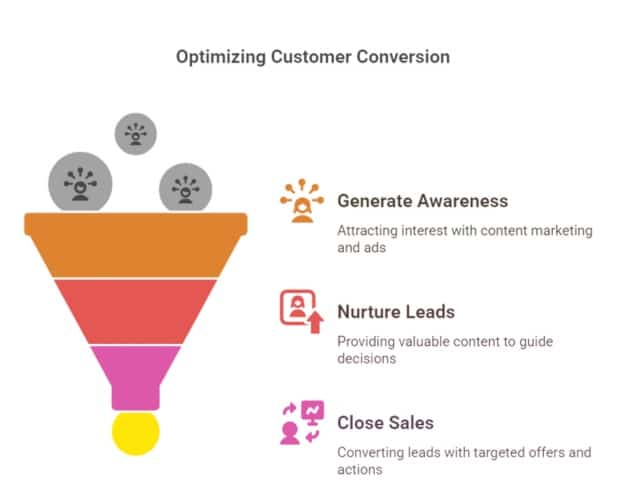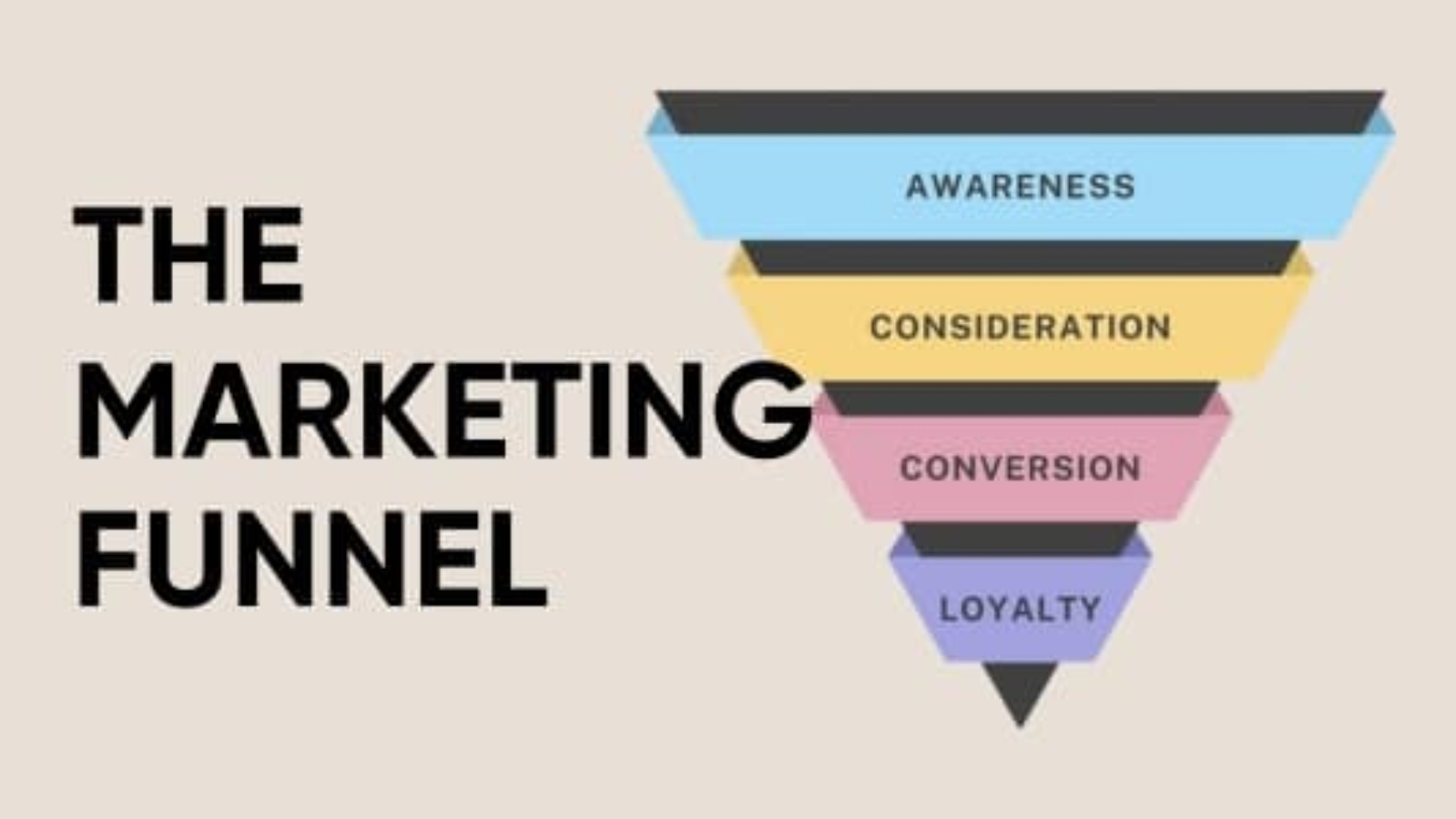A Marketing Funnel is a step-by-step process that guides potential customers from the moment they become aware of your brand to the point where they make a purchase. It is called a “funnel” because, just like a real funnel, many people enter at the top, but only a smaller number make it to the bottom and convert into paying customers.
Why is the Marketing Funnel Important?
✔ Helps businesses understand the customer journey
✔ Creates a structured marketing strategy
✔ Improves lead generation and conversions
✔ Ensures better customer engagement at every stage
The funnel is divided into three main stages:
📌 Top of the Funnel (TOFU) – Awareness
📌 Middle of the Funnel (MOFU) – Consideration
📌 Bottom of the Funnel (BOFU) – Conversion
Each stage plays a crucial role in attracting, nurturing, and converting customers.

Top of the Funnel (TOFU)
The top of the funnel (TOFU) is the awareness stage of the marketing funnel, where potential customers first discover your brand. At this stage, they are not looking to buy immediately; they are just gathering information and exploring solutions to their problems.
Goal of TOFU
✔ Increase brand awareness
✔ Attract potential customers
✔ Educate and engage the audience
The working process of ToFU
1. Understanding the Audience’s Needs
At this stage, people are searching for answers, learning about their problems, and exploring possible solutions. They might Google questions, watch videos, or browse social media for information.
2. Creating Informative & Engaging Content
Since people are looking for knowledge, businesses must provide valuable, educational content to attract and engage them. The best types of content for TOFU include:
✅ Blog Posts & Articles – Informative content that answers customer queries
✅ Social Media Posts & Reels – Engaging visuals and videos to capture attention
✅ YouTube Videos & Podcasts – Explaining concepts in an easy-to-understand way
✅ Infographics & E-books – Visually appealing educational content
3. Using SEO & Social Media to Drive Traffic
Once the content is ready, the next step is to increase its reach using:
📌 SEO (Search Engine Optimization) – Optimizing content to rank on Google
📌 Social Media Marketing – Posting engaging content on Instagram, Facebook, LinkedIn, etc.
📌 Paid Ads for Awareness – Running ads on Google, Facebook, and YouTube to reach a wider audience
The goal of TOFU is not immediate sales but to make people aware of the brand. By offering valuable content, businesses can gain their audience’s trust and move them to the next stage of the funnel—the Consideration Stage (MOFU).
Middle of the Funnel (MOFU)
The middle of the funnel (MOFU) is the stage of consideration in the marketing funnel. At this stage, potential customers know about your brand but are still evaluating their options. They are comparing different solutions and looking for reasons to choose your product or service.
Goal of MOFU
✔ Build trust and credibility
✔ Generate high-quality leads
✔ Provide in-depth information about your product/service
The working process of MoFU
1. Educating and Nurturing Potential Customers
Since potential buyers are still researching and comparing options, businesses need to provide valuable and detailed information to help them make an informed decision.
✅ Case Studies & Success Stories – Show real-life examples of how your product/service has helped others.
✅ Webinars & Live Demos – Engage with potential customers and answer their questions in real time.
✅ Email Marketing & Newsletters – Send personalized content, special offers, and updates to keep leads engaged.
✅ Detailed Product/Service Pages – Provide specifications, features, and benefits to help customers evaluate your offering.
2. Capturing Leads with Lead Magnets
To move potential customers closer to conversion, businesses need to collect their contact details and nurture them with targeted marketing. Lead magnets work best for this.
📌 Free E-books & Guides – Offering valuable insights in exchange for emails.
📌 Discounts & Free Trials – Encouraging potential customers to try the product.
📌 Exclusive Webinars & Consultations – Providing in-depth knowledge and direct interaction.
3. Retargeting & Remarketing Strategies
At this stage, people might visit your website, and check your services, but leave without taking action. To bring them back, businesses use:
📌 Retargeting Ads – Running Google, Facebook, or Instagram ads to re-engage previous visitors.
📌 Follow-up emails – Sending reminders, testimonials, or special offers to potential customers.
📌 Customer Reviews & Testimonials – Showcasing positive experiences to build trust.
Once potential customers trust your brand and see its value, they are ready to take action. The final step is to give them a strong reason to buy, which happens in the Bottom of the Funnel (BOFU).
Bottom of the Funnel (BOFU)
The bottom of the funnel (BOFU) is the conversion stage of the marketing funnel. At this stage, potential customers are ready to make a purchase or take the desired action. They have explored their options, compared different solutions, and now need a final push to choose your brand over competitors.
Goal of BOFU
✔ Convert leads into paying customers
✔ Provide clear reasons to choose your product/service
✔ Remove doubts and objections
The working process of BoFU
1. Offering a Strong Call-to-Action (CTA)
At this stage, your potential customers need a clear direction on what to do next. Your CTA should be direct, persuasive, and encourage immediate action.
✅ “Buy Now” or “Get Started” – Push the customer toward an immediate purchase.
✅ “Book a Free Consultation” – If your service requires discussion before purchase.
✅ “Claim Your Discount” – Limited-time offers create urgency.
2. Providing Strong Purchase Incentives
Sometimes, customers hesitate before making the final decision. To reduce doubts, businesses can offer:
📌 Limited-Time Discounts – Creating urgency with “Last Chance” or “Only 2 Days Left” offers.
📌 Money-back guarantee – Reducing risk and increasing customer confidence.
📌 Bonus Add-Ons – Offering additional benefits, like free setup, extended warranty, or free resources.
3. Social Proof & Trust Signals
To reassure potential customers that they are making the right choice, businesses should showcase:
✅ Customer Testimonials & Reviews – Positive feedback from satisfied customers.
✅ Case Studies & Success Stories – Real-world examples of how the product/service has helped others.
✅ Certifications & Awards – Industry recognition to boost credibility.
4. Simplifying the Checkout & Conversion Process
Even if a customer is ready to buy, a complicated process can lead to drop-offs. To ensure a smooth conversion:
📌 Minimize Form Fields – Ask for only necessary details.
📌 Offer Multiple Payment Options – Credit cards, digital wallets, PayPal, etc.
📌 Fast & Secure Checkout – Ensure a seamless buying experience.
5. Post-Purchase Engagement & Customer Retention
Once a lead converts into a customer, the relationship shouldn’t end. To encourage loyalty and repeat business, businesses should:
✅ Send a Personalized Thank You Email – A simple “Thank You” message builds a strong connection.
✅ Offer Loyalty Programs – Reward customers with discounts or referral bonuses.
✅ Provide Exceptional Customer Support – Address post-purchase concerns quickly.
BOFU is where leads become paying customers. By offering a strong CTA, trust-building elements, and a smooth buying process, businesses can maximize their conversions and grow successfully.
Conclusion
The marketing funnel is essential for digital marketing as it maps the customer journey from awareness to loyalty, enabling brands to deliver targeted, personalized content at each stage. By aligning strategies with decision-making psychology, it maximizes engagement and minimizes wasted efforts. Data-driven insights from the funnel help optimize campaigns, fix leaks, and allocate resources effectively, while post-purchase nurturing fosters advocacy and long-term growth. Ultimately, it merges creativity and analytics, ensuring brands stay customer-centric, adaptable, and impactful in a fast-paced digital world—proving that strategic empathy drives lasting success.




Add a Comment